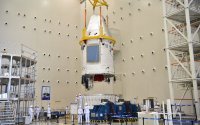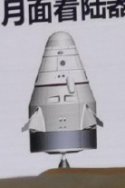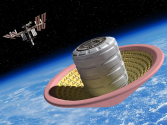Surely not? Tianzhou are not intended to survive re-entry?Can't wait for the cargo supply mission! Side note, does anyone think the inflatable heat shield that was tested last year could be used on this spacecraft?
You are using an out of date browser. It may not display this or other websites correctly.
You should upgrade or use an alternative browser.
You should upgrade or use an alternative browser.
China's Space Program News Thread
- Thread starter crazyinsane105
- Start date
- Status
- Not open for further replies.
It seems the next gen spacecraft will be attached on top of 921 moon rocket using some sort of fairing that cover the service module and protect the solar panels during launch. The fairing also has Launch Abort System (LAS) attached to it.



After launch it will discard the fairing and extend the solar panels

We might see this LAS in pad abort test in a few years and then the first crewed mission for the Next Gen Spacecraft might be a visit to the Space Station in LEO configuration while being launched by LM-7.
Since LM-7 can only launch the 14-ton version I think there will be two different versions of the fairing for LM-7 and the 921 moon rocket respectively.



After launch it will discard the fairing and extend the solar panels

We might see this LAS in pad abort test in a few years and then the first crewed mission for the Next Gen Spacecraft might be a visit to the Space Station in LEO configuration while being launched by LM-7.
Since LM-7 can only launch the 14-ton version I think there will be two different versions of the fairing for LM-7 and the 921 moon rocket respectively.
Last edited:
If its about simplicityThat sounds fishy to say the least. The RD-191 for example can only throttle down to 27% not 10%.
I guess I did not make myself clear. The whole idea is to use a common LOX/Methane first stage engine across all the rockets instead of the combined LOX/Kerosene and LOX/Hydrogen engines currently used or contemplated. The LM-7/8 use the YF-100. The LM-5 uses the YF-100 and YF-77. The Long March 9 will use YF-130 engines. That is three engine types you need to manufacture and certify. This way you need a single engine type for the first stage of all those launchers. That is why I said "common first stage engine" not "common engine".
What SpaceX does with a common first and second stage is kind of beyond the point. SpaceX doesn't want to spend the engineering resources to develop a whole new rocket engine for the second stage which will be manufactured in small numbers and would require the use of different fuel. It is much harder to have ground handling facilities for hydrogen than methane. Just look at the boiling point of both. Methane has similar boiling temperature range to oxygen. Hydrogen is way, way lower. 20.28K for hydrogen. That is 20 degrees above absolute zero. Methane is 111.6K. Oxygen is 90.188K. The Chinese already have hydrogen production, ground handling, and the second stage engines already are in production. So the calculus isn't the same. LM-7 uses the same YF-75 engines on the LM-3A/B/C. The LM-5 uses the YF-75D, which is new, but it is capable of multiple restarts unlike their previous engine.
The move to a common first stage engine has nothing to do with saving fuel cost. It is all about driving down production costs through reducing the types of parts you manufacture. If you have those YF-130 engines only on a LM9 rocket which is launched like only once every couple of years how much do you think you will need to spend to maintain those production facilities, tools, and retain trained staff specialized in manufacturing those engines? The costs will be immense. It makes no sense. They need to rationalize the production chain in the future.
The 5m fairing production cost reductions because the diameter is same as LM-5 have nothing to do with sharing the tank design schematics. It has to do with sharing tools, production facilities, and logistics facilities to move things around. They have existing tooling dimensioned for that already.
The CZ-7 was meant to be a simple re-engine of the CZ-3 didn't turn out that way when they actually started looking at it and it turned into a whole new launcher.
If its about economics
All the engines you mention already exist and are proven so the R&D cost is sunk, production facilities exist and are paid for so that's sunk cost too, what would the ROI be to develop a common methane engine and integrate it into new launchers for mass production? Can it be achieved in the requisite time scales? i.e. does it fit with the goals of the space program?
Current systems provide the necessary capabilities for the projects in hand so looking into the next phase.
What kind of lift capability is needed to build a moon base does a new methane engine development cycle help that at all? or would scaling up the YF-77 provide what's needed? What's the relative risks and time to realisation of both approaches?
If the answers to any of those questions is in the negative then it won't really happen in the current development cycles because it provides no actual real world benefits.
Unfortunately, the real world often intrudes on sound ideas which is why we're nowhere near having world peace!
It would be different for commercial Chinese companies (the actual equivalents to SpaceX) which would come to things with a cleaner slate/more greenfield starting point.
That said Western media likes to hype Space-X and Blue Origin because successive administrations have royally screwed NASA over and having to pay the Russians to use Soyuz and use Russian engines in their heavy lift boosters doesn,t gel well with the 'we are the best' news fodder you can feed your populace. So when those fledgling Chinese commercial companies' prototypes start blowing up like starship there will be the usual 'Chinese made crap' narrative and spray painting of Space-X's failures.
Except it seems to be in consideration. Just look at the last slide @Dante80 posted.
That is clearly a proposal to replace the first stages of all those rockets.
With regards to US "commercial space" companies, SpaceX has proven itself. Blue Origin has not. For what it's worth Blue Origin (2000) was founded before SpaceX (2002). Yet they still haven't launched a single satellite into orbit despite massive spending.
That is clearly a proposal to replace the first stages of all those rockets.
With regards to US "commercial space" companies, SpaceX has proven itself. Blue Origin has not. For what it's worth Blue Origin (2000) was founded before SpaceX (2002). Yet they still haven't launched a single satellite into orbit despite massive spending.
That's a very curious design. Boosting the capsule + service module away from a rocket is a lot harder than just the capsule as with a LES tower, so that would normally necessitate bigger motors. On the other hand this design allows the service module motors to fire concurrently with the abort system motors, that could offset this disadvantage depending on how powerful the service module engines are.It seems the next gen spacecraft will be attached on top of 921 moon rocket using some sort of fairing that cover the service module and protect the solar panels during launch. The fairing also has Launch Abort System (LAS) attached to it.
View attachment 71680
View attachment 71679
View attachment 71678
After launch it will discard the fairing and extend the solar panels
View attachment 71681
We might see this LAS in pad abort test in a few years and then the first crewed mission for the Next Gen Spacecraft might be a visit to the Space Station in LEO configuration while being launched by LM-7.
Since LM-7 can only launch the 14-ton version I think there will be two different versions of the fairing for LM-7 and the 921 moon rocket respectively.
It would give one less separation event though, that's definitely a plus.
Quickie
Colonel
The cost of fuel is negligible compared to the cost of the rocket.
Here are a few energy densities in MJ/kg
Kerosene 43.3
Methane 55.5
Hydrogen 142
So we can see Methane has 28% more energy than Kerosene.
And remember a rocket is carries a lot of fuel in terms of weight.
Any weight saving translates directly into increased payload.
There is also the issue of densities of the fuels which translates to structural issues relating to how large the fuel tanks and rocket stages necessarily ending up being.
The Space Shuttle's huge external fuel tank holding the hydrogen fuel can afford to be relatively thin skin since it doesn't need to provide any kind of structural support to for example the upper stages of the rocket and the payload.
Liquid kerosene has over 10 times the density of liquid hydrogen and about twice the density of liquid methane.
Uncontrolled re-entry is actually a design feature of Long March 5B? After the last one re-entered the atmosphere out-of-control and sprayed houses in Cote d'Ivoire with debris another 20-ton object coming down hard.
What an embarrassment this rocket program is turning out to be.
What an embarrassment this rocket program is turning out to be.
They need to figure out a way to do controlled re-entry for future launches.Uncontrolled re-entry is actually a design feature of Long March 5B? After the last one re-entered the atmosphere out-of-control and sprayed houses in Cote d'Ivoire with debris another one 20-ton object coming down hard.
What an embarrassment this rocket program is turning out to be.
AssassinsMace
Lieutenant General
What is that I smell...? Envy? It reminds me of how Indians were trying to logically make the J-20 illegal. Since China wasn't a democracy, it wasn't okayed by the Chinese people so the world should make the J-20 illegal by international law. All that bull just to cover-up envy.
- Status
- Not open for further replies.

